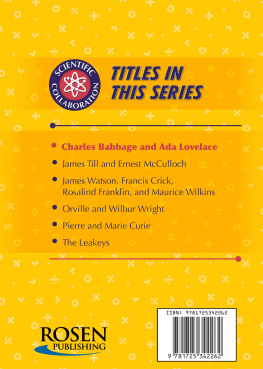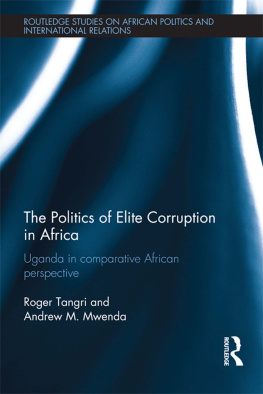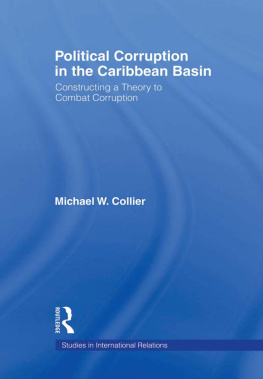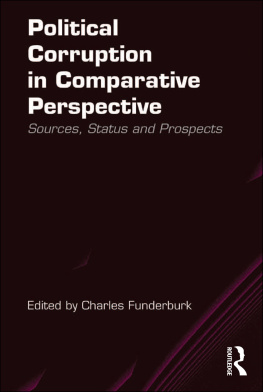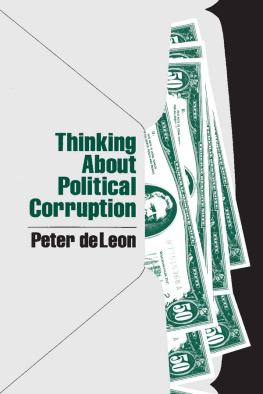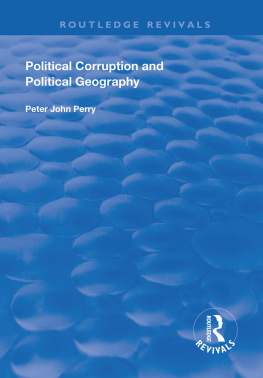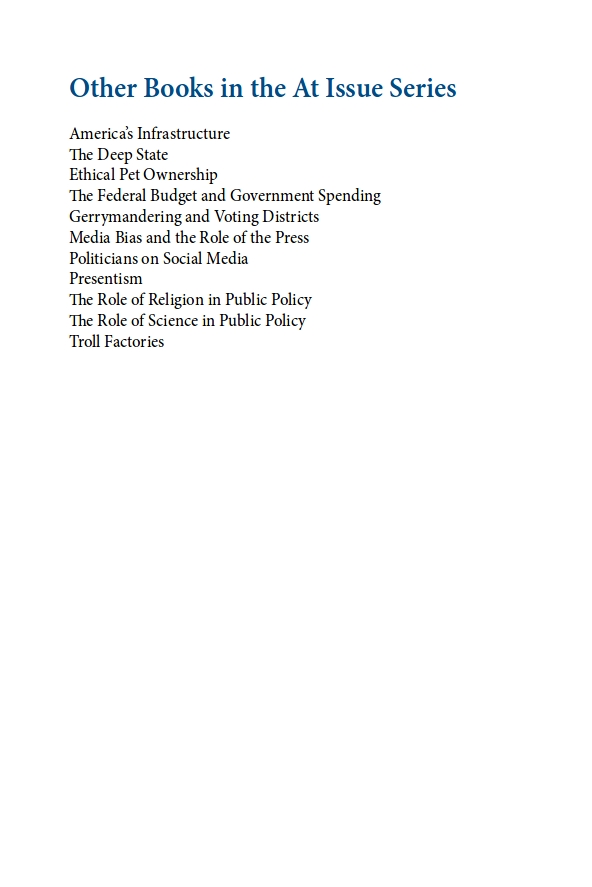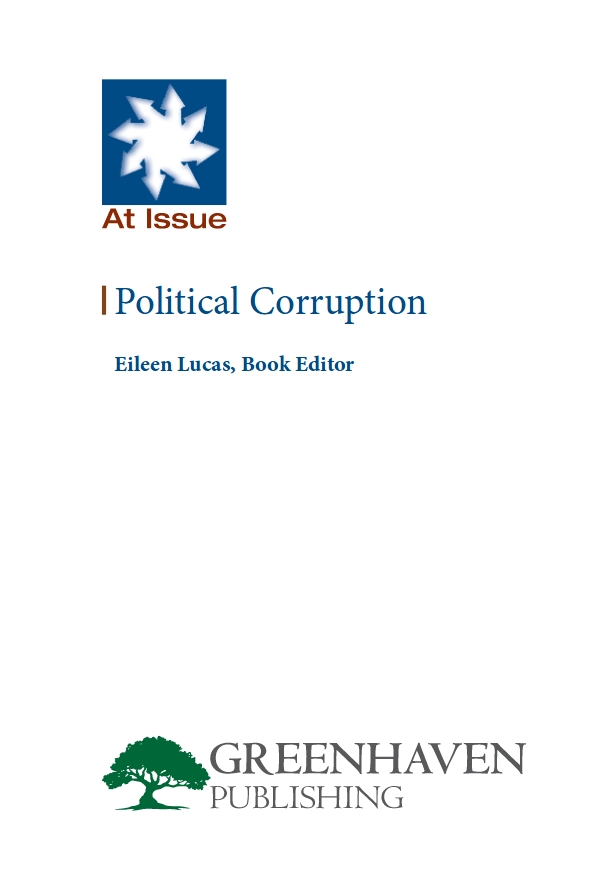353 3rd Avenue, Suite 255, New York, NY 10010
Copyright 2019 by Greenhaven Publishing, LLC First Edition
All rights reserved. No part of this book may be reproduced in any form without permission in writing from the publisher, except by a reviewer.
Articles in Greenhaven Publishing anthologies are often edited for length to meet page requirements. In addition, original titles of these works are changed to clearly present the main thesis and to explicitly indicate the authors opinion. Every effort is made to ensure that Greenhaven Publishing accurately reflects the original intent of the authors. Every effort has been made to trace the owners of the copyrighted material.
Cover image: Carlos Yudica/Shutterstock.com
Library of Congress Cataloging-in-Publication Data
Names: Lucas, Eileen, editor.
Title: Political corruption / Eileen Lucas, book editor.
Description: First edition. | New York : Greenhaven Publishing, LLC, 2019. |
Series: At Issue | Audience: Grades: 9 to 12. | Includes bibliographical references and index.
Identifiers: LCCN 2018025299| ISBN 9781534503809 (library bound) | ISBN 9781534504479 (paperback)
Subjects: LCSH: Political corruptionUnited StatesJuvenile literature.
Classification: LCC JK2249 .P63 2019 | DDC 364.1/3230973dc23 LC record available at https://lccn.loc.gov/2018025299
Manufactured in the United States of America
Website: http://greenhavenpublishing.com
Contents
Esteban Ortiz-Ospina and Max Roser
John Joseph Wallis
Voice of America
Oguzhan Dincer and Michael Johnston
Judy Nadler and Miriam Schulman
G. William Domhoff
Scott Sumner
Gary Beckner and Richard Posner
Represent.Us
Andrew Gumbel
Transparency International
Jermyn Brooks
Augusto Lopez-Claros
Mariana Ceratti
Represent.Us
Introduction
P olitical corruption, defined by Transparency International as the abuse of entrusted power for private gain,1 has existed since the beginning of civilization. It was certainly on the minds of Americas Founding Fathers as they worked to create a government of, by, and for the people. Records from the debates surrounding the drafting of the US Constitution reveal deep-seated concerns regarding the abuse of power.
James Madison, one of the Constitutions primary authors, believed that a key function of government in a free society was its ability to provide balance between the various competing interests that exist and act in the larger public interest rather than the narrow interest of a particular faction. He distinguished true self-government from government by corrupt influence, which substitutes the motive of private interest in place of public duty; converting its pecuniary dispensations into bounties to favorites, or bribes to opponents. A corrupt government, Madison wrote, enlists an army of interested partisans, whose tongues, whose pens, whose intrigues and whose active combinations, by supplying the terror of the sword, may support a real domination of the few, under an apparent liberty of the many.2
In more current times, author and professor Zephyr Teachout maintains that a dangerous shift has occurred in attitudes and practices relating to political corruption since the final decades of the twentieth century. In Corruption in America, Teachout asserts that the Supreme Court has thrown out many of the rules that had been in place to protect American government from the forces of corruption. This has led to an overflow of private industry involvement in political elections and the rapid decline in the civic ethic in Congress and the state houses as well as the 2010 Supreme Court decision commonly referred to as Citizens United, dealing with campaign spending by organizations.3
Between the writing of the Constitution and the fallout from the Citizens United decision, the debate about what constitutes political corruption and under what circumstances it is or it is not a crime has continued to rage. Although its definition appears simple, the manifestations of political corruption are not. As authors Ray Fisman and Miriam A. Golden state in their book Corruption, What Everyone Needs to Know, Corruption appears in many distinct forms and displays many shades of gray.4 Many obviously corrupt activitiessuch as embezzlement, vote buying, and theft of public resourcesare also illegal. However, there are others that fall in a gray area, where they may not actually be illegal, but are still deemed by many to be corrupt.5 For instance, one might ask: Was it corrupt for US Treasury Secretary Timothy Geithner to become president of a company hed been charged with regulating just over a year after leaving office? Perhaps it was not illegal, but whether or not it was in the publics best interest may be another story.
A brief selection of some of the most noteworthy proven cases of political corruption in American history includes the following:
The Yazoo land scandal of the early 1800s: Essentially, Georgia state legislators were paid by speculators to sell land at discounted prices. Even after the state of Georgia determined that the deal had been corrupt and cancelled it, these investors continued to sell the land at inflated prices.
The Credit Mobilier scandal of 1867: Several high-ranking congressmen who were all close supporters of former General of the Union Army and soon-to-be President Ulysses S. Grant were given or allowed to cheaply purchase stock in the Credit Mobilier of America company, which was involved in the funding and construction of the Union Pacific Railroad. These congressmen turned that stock into a huge pot of gold and clearly used their public positions for private gain.
Tammany Hall politics of the mid-to-late-1800s: Boss William Tweedone of the most famous members of New Yorks Tammany Halland his cronies ran New York City in the Civil War era as their own private money factory. Tweeds corruption was said to have earned him approximately $200 million, an almost unimaginable sum of money for the time.
The Teapot Dome scandal of the 1920s: After the Department of the Interior was given control of naval oil reserve lands, Secretary of the Interior Albert B. Fall converted public lands into personal gain when he accepted bribes in exchange for rights to the Teapot Dome Reserve in Wyoming, which he granted to the Mammoth Oil company. Upon investigation, Fall was found to have received over $100,000 in bribes.
Operation Greylord in Chicago in the 1970s and 80s: The Cook County Circuit Court system based in Chicago was believed to be so corrupt that two federal investigations were undertaken to expose it. As a result of the investigation, several judges were sent to jail including Judge Thomas J. Maloney. During the years he spent on the county court bench, Maloney fixed as many as six murder trials and took bribes of up to $100,000 from gangs to convict members of other gangs for murder.
The Watergate scandal: One of the most prominent examples of political corruption in US history began with a break-in at the Democratic headquarters in the Watergate Hotel in Washington, DC, by five members of president Richard M. Nixons re-election campaign. Although not initially involved, Nixon found out about the break-in and did everything he could to cover it up. He was ultimately forced to resign as a result.


